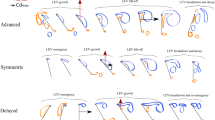Abstract
In the present study, we numerically investigate three-dimensional flow structures around a butterfly-shaped low-aspect-ratio wing and their effect on the aerodynamic force at the Reynolds number of 1000 based on the wing chord length and free-stream velocity. When the angle of attack is less than 10°, the flow is steady and fully attached to the upper-wing surface, by which the lift force increases almost linearly with the angle of attack. As the angle of attack further increases, the flow around the wing becomes unsteady and contains the leading-edge, trailing-edge, wing-tip, and hairpin vortices. At these angles of attack, the drag force increases rapidly with increasing angle of attack due to massive separation at the leading edge, but the lift force increases gradually without abrupt fall-off. This is because the wing-tip vortices induce a strong downward flow interacting with the flow separated from the leading edge and delay subsequent vortex roll-up in the downstream. The wing-tip vortices themselves also produce low-pressure regions on the upper-wing surface and thus provide an additional lift force. The flows separated from the leading and trailing edges are eventually combined into pairs of hairpin vortices which travel downstream in the wake. The formation of the hairpin vortices above the upper-wing surface also generates lowpressure regions, and they are another source of the lift force.
Similar content being viewed by others
References
P. B. S. Lissaman, Low-Reynolds-number airfoils, Annu. Rev. Fluid Mech., 15 (1983) 223–239.
T. J. Mueller and J. D. DeLaurier, Aerodynamics of small vehicles, Annu. Rev. Fluid Mech., 35 (2003) 89–111.
D. J. Pines and F. Bohorquez, Challenges facing future micro- air-vehicle development, J. Aircraft, 43 (2006) 290–305.
W. Shyy, Y. Lian, J. Tang, D. Viieru and H. Liu, Aerodynamics of low Reynolds number flyers, Cambridge University Press New York, USA (2008).
J. Kwon and H. Choi, Sectional lift coefficient of a flapping wing in hovering motion, Phys. Fluids, 22 (2010) 071703.
H. Park and H. Choi, Kinematic control of aerodynamic forces on an inclined flapping wing with asymmetric strokes, Bioinspir. Biomim., 7 (2012) 016008.
B. H. Carmichael, Low Reynolds number airfoil survey Volume I, NASA-CR-165803 (1981).
G. E. Torres and T. J. Mueller, Low-aspect-ratio wing aerodynamics at low Reynolds numbers, AIAA J., 42 (2004) 865–873.
K. Taira and T. Colonius, Three-dimensional flows around low-aspect-ratio flat-plate wings at low Reynolds numbers, J. Fluid Mech., 623 (2009) 187–207.
J. J. Wang and J. Q. Tu, Effect of wing planform on leading- edge vortex structures, Chinese Sci. Bull., 55 (2010) 120–123.
M. Okamoto and A. Azuma, Aerodynamic characteristics at low Reynolds numbers for wings of various planforms, AIAA J., 49 (2011) 1135–1150.
A. Pelletier and T. J. Mueller, Low Reynolds number aerodynamics of low-aspect-ratio, thin/flat/cambered-plate wings, J. Aircraft, 37 (2000) 825–832.
P. Cosyn and J. Vierendeels, Numerical investigation of low-aspect-ratio wings at low Reynolds numbers, J. Aircraft, 43 (2006) 713–722.
S. Sunada, T. Yasuda, K. Yasuda and K. Kawachi, Comparison of wing characteristics at an ultralow Reynolds number, J. Aircraft, 39 (2002) 331–338.
T. Jian and Z. Ke-Qin, Numerical and experimental study of flow structure of low-aspect-ratio wing, J. Aircraft, 41 (2004) 1196–1201.
Y. Lian and W. Shyy, Three-dimensional fluid-structure interactions of a membrane wing for micro air vehicle applications, AIAA Paper 2003-1726 (2003).
D. R. Morse and J. A. Liburdy, Vortex dynamics and shedding of a low aspect ratio, flat wing at low Reynolds numbers and high angles of attack, J. Fluids Eng., 131 (2009) 051202.
C. P. Ellington, Insects versus birds: the great divide, AIAA Paper 2006-35 (2006).
J. J. Videler, E. J. Stamhuis and G. D. E. Povel, Leadingedge vortex lifts swifts, Science, 306 (2004) 1960–1962.
E. A. Leylek, J. E. Manzo and E. Garcia, Bat-inspired wing aerodynamics and optimization, J. Aircraft, 47 (2010) 323–328.
H. Park and H. Choi, Aerodynamic characteristics of flying fish in gliding flight, J. Exp. Biol., 213 (2010) 3269–3279.
H. Choi, H. Park, W. Sagong and S.-I. Lee, Biomimetic flow control based on morphological features of living creatures, Phys. Fluids, 24 (2012) 121–302.
Y. Hu, J. J. Wang, P. F. Zhang and C. Zhang, Experimental investigation on the flow structure over a simplified Papilio Ulysses model, Chinese Sci. Bull., 54 (2009) 1026–1031.
Y. Hu and J. J. Wang, Experimental investigation on aerodynamic performance of gliding butterflies, AIAA J., 48 (2010) 2454–2457.
Y. Hu and J. J. Wang, Dual leading-edge vortex structure for flow over a simplified butterfly model, Exp. Fluids, 50 (2011) 1285–1292.
M. Okamoto, S. Sunada and H. Tokutake, Stability analysis of gliding flight of a swallowtail butterfly Papilio xuthus, J. Theor. Biol., 257 (2009) 191–202.
M. Okamoto, S. Sunada and H. Tokutake, Stability of gliding flight of a swallowtail butterfly, AIAA J., 48 (2010) 2970–2976.
H. Park, K. Bae, B. Lee, W.-P. Jeon and H. Choi, Aerodynamic performance of a gliding swallowtail butterfly wing model, Exp. Mech., 50 (2010) 1313–1321.
A. K. Brodsky, The evolution of insect flight, Oxford University Press New York, USA (1994).
J. Kim, D. Kim and H. Choi, An immersed-boundary finite-volume method for simulations of flow in complex geometries, J. Comput. Phys., 171 (2001) 132–150.
P. R. Spalart, R. D. Moser and M. M. Rogers, Spectral methods for the Navier-Stokes equations with one infinite and two periodic directions, J. Comput. Phys., 96 (1991) 297–324.
J. Jeong and F. Hussain, On the identification of a vortex, J. Fluid Mech., 285 (1995) 69–94.
Author information
Authors and Affiliations
Corresponding author
Additional information
Recommended by Editor Dongshin Shin
Rights and permissions
About this article
Cite this article
Lee, B., Seong, J., Park, H. et al. Flow structures around a butterfly-shaped low-aspect-ratio wing. J Mech Sci Technol 28, 2669–2675 (2014). https://doi.org/10.1007/s12206-014-0623-3
Received:
Revised:
Accepted:
Published:
Issue Date:
DOI: https://doi.org/10.1007/s12206-014-0623-3




